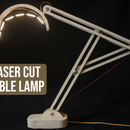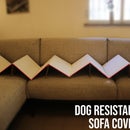Introduction: Elevated Wooden Deck (With Stairs)
It's been a while since my last instructable, but I'm back!
I this instructable I'll show you I built an elevated wooden deck (with stairs). I will consider 3 separate parts:
- Base, frame & flooring
- Railings
- Stairs
Each part was designed given a different set of considerations, and will interest a different group of people. Feel free to skip to the part you're interested in. In each part, I'll include plans and the list of materials you'll need to make your version.
Time required - building the base, frame and flooring takes about one day (8 hours) for 2 people (a third person is helpful for some of the lifting). Adding the railings takes about 8 more hours (for 1 person), and adding the stairs takes about one more day (8 hours) for two people.
Safety Disclaimer
I'm not an civil engineer or an architect, and I built this deck as a DIY effort - for my own home. While I looked at other decks before designing mine, keep in mind that this is not my profession, and proceed at your own risk. Make sure you follow your local regulations and code (which may differ from mine), and consult with professionals if needed.
Building your own deck requires some adjustments. No single design fits all! Double check that the dimensions are good for you, and that all calculations make sense. Make sure you read through, and that you find the logic between the different steps.
I hope you find this useful! Feel free to leave any questions or comments
Supplies
Tools:
- Circular saw
- Jigsaw
- 5m tape measure
- Ruler (30cm or longer)
- Drill (with wood drill bits)
- Impact driver
- Spirit level
Step 1: Base
Important tip - this part of the instructable is probably the most sensitive part when it comes to safety. Make sure you're certain about your plan for the base. My version works perfect for me, but some countries have different regulations and use different kinds of wood, so you may need to modify the design. While building a deck, the main structural consideration is weight transfer. You want the weight of the deck itself and the people standing on it to be transferred to the ground efficiently. It's tempting to rely on screws to hold down weight, but that's usually a pretty bad solution.
The deck I built is 4.2 x 2.9 meters (13.8 x 9.8 feet) because where I live, most wooden planks come in pieces of 4.2 meters. You can cut it to any size you like, but it seemed easier to use a standard size.
The base of the deck is made of pillars (10x10 cm or 4" x 4"), connected by two 5x10cm (2" x 4") boards. The frame of the deck will be placed on top of the two 5x10 boards. The weight of the deck will be evenly distributed along these two 5x10 boards which will transfer the weight down to the ground.
The other side of the frame is attached to our house on the other (decks usually form a continuation of something, so my design is pretty generic in that sense). I also added a 4th pillar (with a 5x10 board) in the center of the deck and posts at the house-side, just to be on the safe side. It's easier to assemble the additional pillar after the deck is already built.
Materials:
- 10cm x 10cm (4" x 4") wooden pillars (length varies according to your needs). If you deck is going to be taller than about 1.2m, you should use thicker pillars (6" or even 8", depending on height).
- 5cm x 10cm (2" x 4") boards - three 4.2m pieces (stock size).
- 5cm x 10cm (2" x 4") boards - two 0.7m pieces (for the diagonals).
- Pillar mounts (to connect the pillars to the foundations).
You'll also need 16 8cm (3") wood screws, 6 12cm (5") wood screws, and a concrete mix for the foundations (if needed).
Assembly:
- Cast 3 concrete foundations for the pillars to sit on. The center of these foundations should be about 10-20cm away from the front of the deck, and about 1.9m apart (notice that they're not placed at the edge of the deck). The pillar at the middle should mark the middle of your deck, and the other two should be on either side.
- Cast 1 additional support at the center of the deck. This will be used as an additional support which will be added later on.
- Attached appropriate mounts for the wooden pillars (see first image).
- Measure and cut the pillars so that their top is leveled. The top side of the floor is going to be about 23 cm above them (see next steps), so make sure it's the right height for you.
- Attach the pillars in place.
- Attached the two 5x10 (4.2m long) so that their tall side is perpendicular to the floor (see 2nd and 3rd images). This configuration is sturdier than the rotated version.The 5x10 boards should be centered with respect to the middle pillar.
- Make sure everything is leveled (or at least within your tolerance!).
- For additional stability, add two diagonal boards connecting the 5x10 boards to the pillars (see 2nd and 3rd images).
Step 2: Frame
Materials
- 5cm x 10cm (2" x 4") - two 4.2m (13.8 feet) pieces
- seven 2.9m (9.5 feet) pieces
You'll also need 28 8cm (3 inch) wood screws.
Assembly:
- On a flat surface, lay out the pieces as in the images - two long boards connected by seven evenly spaced shorter ones. The 2.9m pieces should be about 70cm apart from each other. Notice that the 10cm (4") face is perpendicular to the floor. This makes the frame more durable and less flexible.
- Screw the outermost boards to make the external frame. I used two screws for each joint (last image)
- Make sure everything is square.
Step 3: Frame Assembly
Materials
- 8 pieces of 12cm (5") wood screws.
- Mounts & screws to attach the deck to your house / floor on the opposite side of the pillars.
For this part, a 3rd person will be very helpful during the lifting.
Assembly:
- Lift the frame and lay it on the base (see first image).
- Make sure the frame is leveled, and attach it to the house / floor on the opposite side of the pillars.
- Attach the frame to the 5x10 boards laying on the pillars.
See 2nd image for the desired results.
Step 4: Flooring
It's time to add the floor!
Materials:
- 3cm x 14cm boards - 19 pieces of 4.2m (stock size).
- 306 7cm (a little less than 3") wood screws.
Assembly:
- Lay out the 3x14 boards across the frame.
- Use a couple of 5mm spacers to roughly spread the boards along the deck frame.
- Once the spacing seems to make sense, screw in the first and last pieces (one from either side of the deck).
- Starting from either side, use the 5mm spacers, and add the rest of the boards one by one. As you get close to the edge of the deck, make double check that the spacing makes sense, and make minor adjustments where necessary.
Before moving on to the next steps, this is a good point to sit back and enjoy a long break.
Step 5: Railing (Posts & Hand Rails)
The next steps will be presented a bit differently. Since every deck is placed in a different scene, the the railings and stairs will be different. So, I'll share my design and tips, but not exact quantities and instructions.
Materials
- The railing posts will be made of 5cm x 10cm (2" x 4") boards.
Note that there are regulations and standards when it comes to railings. I followed the ones in my country, which specify that railings should be 105cm (41.3") tall.
Assembly:
- The posts are made of 5x10 boards, where the posts at each of the deck corners will be made of two connected 5x10 boards.
- To make a corner post, attach two 5x10 boards cut to 100cm (39.4") and 110cm (43.3"). so that one of their ends is aligned. Connect the post to the edge of the deck, as shown in the first image. The longer board should stick out beneath the deck floor, so it can be attached more firmly.
- After the corner posts are attached, add the rest of the posts. Evenly-distribute the posts about 90-100cm apart (35-39") You can use double boards for these as well (like for the corner posts), but it's not strictly necessary. I used single boards cut to 100cm (see second image).
- Attach the hand rails. These are long 5x10 boards that should be laid flat on the posts (see images 3 & 4).
If you want to add a roof, making the posts tall enough for the roof to lay on might be a good idea (it turned out very convenient for me).
Step 6: Railing (Grating)
Gratings also have safety standards. They must be designed so that kids can't climb them too easily, and that their heads can't pass between bars. My design for the grating is made of of 2x4 (0.8" x 1.6") spaced 10cm apart from each other.
Materials
- 2cm x 4cm (0.8" x 1.6") bars cut to 99cm (lots of them).
- 4cm x 4cm (1.6" x 1.6") boards.
Assembly:
- The 2x4 bars will be attached to 4x4 boards - at the top of the railings and one at the bottom.
- See first & second images. Cut the 4x4 boards to size, and attach them so that they're flush with the inner side of the deck. They should form a step or a socket of some sort with the hand rails and the deck floor, so that the 2x4 bars can be attached without protruding.
- Cut the 2x4 bars to size (just a bit short compared to the distance from the floor to the hand rests).
- Attach the 2x4 bars 13cm (5.2") apart (center to center). This way the distance between each edge of a bar to the next one is 9cm, which is less than 10cm (4"), a common safety standard (see 3rd & 4th images).
Step 7: Stairs (Steps)
Stairs are probably the trickiest part of all, since the details here matter most. The important things is that there are strict standards on how stairs should be designed, and if these standards are not met, people may stumble. We're very used to standard steps.
The most important parts are the dimensions of the rise and tread (see second image). Where I come from, the rise should be 17-17.5cm and the tread should be at least 26cm. To decide how many steps you'll need you can either use a stairs calculator (google it :) or divide the height you'll need to cover by 17-17.5 cm (remember that you can't have a step & a half!!)
Materials
- 3cm x 14cm boards (same as flooring). Each step requires one piece cut to 100cm and another one cut to 108cm.
- 5x10 boards (2" x 4"). (cut to 27cm).
Assembly:
- For each step, attach the two 3x14 boards to a 5x10 so that the longer 3x13 sticks out about 4cm on either side (see 3rd & 4th images).
- Repeat until you've made enough steps (5th image).
** I mentioned you should us 3x14 boards for the steps. However, the wood supplier was out of stock, and convinced me to use 2x14. DO NOT DO THIS. I had to to reinforce all of the steps since they had an annoying flex when you stepped on them. 3x14 boards will work great.
Step 8: Stairs (Frame & Assembly)
The steps will be laid on thick boards (supports) from either side. As mentioned in the previous step, it is crucial to make sure the incline is very close to perfect. Overall, if you read my entire instructable, this is my most important tip:
use an angle guide!!
I laser-cut a triangle with the current dimensions, and also smaller ones with a similar aspect ratio (DXF attached). I then used the angle guide to mark all of the cuts so that the steps are parallel to the floor. This made an impossibly difficult task easy. I can't stress enough how useful this was. Make one!! You can cut one out of cardboard if you need.
Materials
- 5cm x 20cm boards (2" by 8") or thicker for the steps to be installed on.
- 5x10 boards (2" x 4").
- Pillar mounts (to connect the pillars to the foundations).
- Screws.
Assembly:
- Cut the support boards (5x20 boards) to roughly their final size.
- Using the small or medium angle guides, mark a groove for the first step to lay on. These grooves should be protrude about 4-6cm (3-4") into the support boards (see first & third images).
- Mark the center of the next step by using the large angle guide (175mm by 260mm) - see second image.
- Repeat until all grooves are marked.
- Using a jigsaw, cut out the triangles you just marked.
- Assemble the main support boards at their final location. Use the angle guide to cut the the part touching the floor and the deck.
- Before screwing the support boards into place, lay a few of the steps on the grooves and make sure everything is evenly spaced.
- After the main support boards are attached (still without the supporting pillars), lay the steps one by one, and screw them in place.
- Use 5x10 boards to form supporting pillars to hold the stairs and connect them firmly to the ground (see 4th drawing). One pillar on each side of the stairs every 1 meter suffice.
- Connect the pillars to the ground using appropriate mounts.
I wish I had more pictures of this step, but in the heat of the moment I forgot to capture them. So feel free to ask questions!
Attachments
Step 9: Stairs - Railings
The railings I built for the stairs are very similar to the ones I made for the main part of the deck. The only modifications are that the hand rail is supposed to be 95cm tall, instead of 105cm. I used the angle guide very intensively here too, just to make sure all parts are aligned correctly. Also, I used the 2cm x 4cm boards to make the bars and the grating frame (see second image).
Materials
- 5cm by 10cm (2" x 4") boards.
- 2cm x 4cm (0.8" x 1.6") bars.
- Short screws (3cm / 1.2")
Assembly:
- Construct the frame of the railings using 5x10 boards. Use the angle guide to mark the cuts (first image).
- Use 2x4 (cm^2) boards to make the grating frame (same technique as in step 6 of this article, but with thinner poles) - see second image.
- Cut and connect the grating bars so that their center is 13-14cm apart. Notice that you should measure this distance horizontally, and not along with stairs. Otherwise, your bars will be too close (which is technically fine, but is also a waste of material). See 3rd image
Are your stairs sturdy? Do they fill firm when you step on them? Is everything well secured?? Remember your loved ones are going to walk these steps (see 4th image :)
Step 10: Things to Improve!
There are a few things I improved on the original design during the work. All of these modifications are already mentioned in the previous steps, but since these were important I decided to give them proper room.
- I added an extra support in the center of the deck. Without it, the deck feels pretty bouncy. It would hold perfectly fine, but since wood has a certain flex to it and the rods are long, the deck felt a bit too flexible in its center.
- The stairs should be constructed of at least 3cm (2.2") thick boards. The wood supplier pressured me into buying 2cm boards and it was a huge mistake. I had to reinforce all of the steps and I'll probably replace them some day.
- I added a roof, but the instructable turned out too long anyways. If you reached the point where your deck is done and all you need to add is a roof, I'm absolutely sure you'll manage. If you want any tips or help, leave a comment and I'll be happy to help :)
- Applying deck oil is necessary when using some kinds of wood. I used pine wood, which requires an oil treatment every year!
- It's a good idea to paint the deck pillars with tar or something similar (the part that's touching the ground). Making it water-proof will make it last longer.
If you have any other suggestions, I'll be happy to hear them!
Step 11: All Done!
You're all done! Sit back, and enjoy the view!
I hope you enjoyed reading and that you found some this article useful.
If you like my instructable and want to see more, you're welcome
to visit my instructables page and my website
And if you want to consider supporting my work (for free), visit my YouTube channel, see if you like what I've done so far, and consider subscribing! See you soon :)





